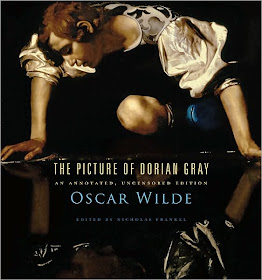An excerpt from a review at the time of initial publication in 1890:
It is a tale spawned from the leprous literature of the French decadents -- a poisonous book, the atmosphere of which is heavy with the mephitic odours of moral and spiritual putrefaction -- a gloating study of the mental and physical corruption of a fresh, fair and golden youth, which might be fascinating but for its effeminate frivolity, its studied insincerity, its theatrical cynicism, its tawdry mysticism, its flippant philosophizings....
As noted in a Salon column this week -
"Unclean," "corruption," "leprous," "putrefaction," and "French decadents" were of course all coded terms for "homosexuality" -- a word that would not enter the English language until two years later, and a concept that could not be openly discussed in a respectable newspaper of the time, nor mentioned in polite company; when "Dorian Gray" was revised for publication in book form a good portion of the material deemed unclean and leprous had to be removed...
Strangely, considering the cult status that "The Picture of Dorian Gray" would eventually attain, Wilde's original version has never been published until now, more than 120 years after the Lippincott edition. It has been made available by Harvard's Belknap Press in a richly annotated and illustrated volume edited by Nicholas Frankel...
Frankel has provided a wealth of supplemental material and visual matter, as well as a "Textual Introduction" and a series of notes that explain references and cultural context, help the reader understand the editing processes, and point out the passages that were singled out for deletion...
Whether the original text is actually "better" than the book version published in 1891 is a moot point. Some of Wilde's original material may have been lost in the latter (even the word "mistress" was deemed unsuitable for publication at that time, and the novel's heterosexual material was censored as ruthlessly as its homosexual innuendos). But much was gained, too, in the expanded version that Wilde prepared in 1891, with the brilliant Lord Henry being given some wonderful new material. This annotated version, though a treasure for scholars and for anyone with a serious interest in Wilde, the 1890s, and aestheticism, should serve as a supplement to the standard text rather than a replacement.
More at the link. There have been quite a few cinematic adaptations of The Picture of Dorian Gray; perhaps better, in my view, is the biographical movie
Wilde, starring Stephen Fry.

I was pleased at how admirably the original B&W version of A Picture of Dorian Gray held up on recent viewing- it was an absolute delight! All I remember as a child was the great unveiling in the last scene that scared the living bejesus outta me!
ReplyDelete